

Fibers - A Healthy Digestive System Benefits the Whole Body - by Brenda Watson, C.N.C. By Brenda Watson, C.N.C.

We take antacids to relieve heartburn and indigestion. We suffer through gas and bloating after meals and even disregard the occasional bout of constipation. But do we ever really stop to think about how our actions are affecting our bodies? Your digestive system is more important than you may think, and poor nutrition may not only lead to discomfort, but it can also trigger a whole host of other issues that may put your digestive health in jeopardy. Unhealthy habits, such as eating too quickly or consuming too many processed foods, can lead to a build-up of undigested food in our intestines. Digestive System: Facts, Function & Diseases. The human digestive system is a series of organs that converts food into essential nutrients that are absorbed into the body and eliminates unused waste material.
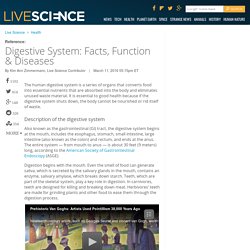
It is essential to good health because if the digestive system shuts down, the body cannot be nourished or rid itself of waste. Also known as the gastrointestinal (GI) tract, the digestive system begins at the mouth, includes the esophagus, stomach, small intestine, large intestine (also known as the colon) and rectum, and ends at the anus. The entire system — from mouth to anus — is about 30 feet (9 meters) long, according to the American Society of Gastrointestinal Endoscopy (ASGE).
Digestion begins with the mouth. JSTOR: Journal of Marriage and Family, Vol. 62, No. 1 (Feb., 2000), pp. 212-227. Academic OneFile - Document. - National Digestive Diseases Information ClearinghouseYour Digestive System and How It Works. On this page:
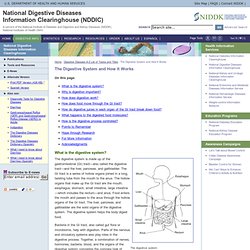
Gastric acid. Gastric acid is a digestive fluid, formed in the stomach.
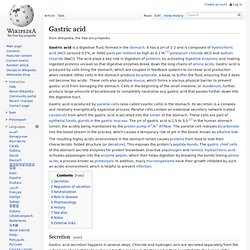
It has a pH of 1-2 and is composed of hydrochloric acid (HCl) (around 0.5%, or 5000 parts per million) as high as 0.1 M,[1] potassium chloride (KCl) and sodium chloride (NaCl). The acid plays a key role in digestion of proteins, by activating digestive enzymes, and making ingested proteins unravel so that digestive enzymes break down the long chains of amino acids. Gastric acid is produced by cells lining the stomach, which are coupled in feedback systems to increase acid production when needed. Other cells in the stomach produce bicarbonate, a base, to buffer the fluid, ensuring that it does not become too acidic. These cells also produce mucus, which forms a viscous physical barrier to prevent gastric acid from damaging the stomach.
Secretion[edit] Enzymes & Digestion. Walter and Eliza Hall Institute of Medical Research. Coeliac disease is a serious and lifelong condition where dietary gluten – a protein found in wheat, rye, barley and oats - causes damage to the small intestine and a range of medical problems.

What is coeliac disease? Coeliac disease is caused by an inappropriate immune response to gluten in the diet. Digestion. Digestion is the breakdown of food into smaller components that can be more easily absorbed and assimilated by the body.

In certain organisms, these smaller substances are absorbed through the small intestine into the blood stream. The Parietal Cell: Mechanism of Acid Secretion. The best-known component of gastric juice is hydrochloric acid, the secretory product of the parietal, or oxyntic cell.
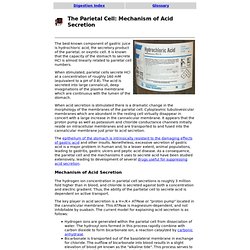
It is known that the capacity of the stomach to secrete HCl is almost linearly related to parietal cell numbers. When stimulated, parietal cells secrete HCl at a concentration of roughly 160 mM (equivalent to a pH of 0.8). Alpha-amylase. Α-Amylase is a protein enzyme EC 3.2.1.1 that hydrolyses alpha bonds of large, alpha-linked polysaccharides, such as starch and glycogen, yielding glucose and maltose.[2] It is the major form of amylase found in humans and other mammals.[3] It is also present in seeds containing starch as a food reserve, and is secreted by many fungi.

In human physiology[edit] Although found in many tissues, amylase is most prominent in pancreatic juice and saliva, each of which has its own isoform of human α-amylase. They behave differently on isoelectric focusing, and can also be separated in testing by using specific monoclonal antibodies. In humans, all amylase isoforms link to chromosome 1p21 (see AMY1A). Salivary amylase (ptyalin)[edit] Digestive enzyme. Digestive enzymes are classified based on their target substrates: proteases and peptidases split proteins into small peptides and amino acids.lipases split fat into three fatty acids and a glycerol molecule.carbohydrases split carbohydrates such as starch and sugars into simple sugars such as glucose.nucleases split nucleic acids into nucleotides.
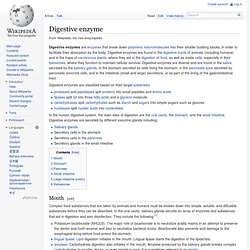
In the human digestive system, the main sites of digestion are the oral cavity, the stomach, and the small intestine. Digestive enzymes are secreted by different exocrine glands including: Dave Moulton's Blog - Dave Moulton's Bike Blog - Running vs. Cycling: Burning Calories. Running requires the same amount of energy to run one mile at any speed; you burn 110 calories per mile.

It doesn’t matter if you are a super fit athlete, or an out of shape beginner you will still burn the same number of calories per mile. However, bike riding is affected by wind resistance so the faster you ride, the more energy you use, and the more calories you burn. You have to compare running and cycling at different cycling speeds. How Does Smoking Affect the Muscular System? Maximal accumulated oxygen deficit i... [Appl Physiol Nutr Metab. 2011. - National Digestive Diseases Information ClearinghouseYour Digestive System and How It Works. Biomechanics of Skeletal Muscles - Vladimir Zatsiorsky, Boris Prilutsky. Richly illustrated and presented in clear, concise language, Biomechanics of Skeletal Muscles is an essential resource for those seeking advanced knowledge of muscle biomechanics.
Written by leading experts Vladimir Zatsiorsky and Boris Prilutsky, the text is one of the few to look at muscle biomechanics in its entirety—from muscle fibers to muscle coordination—making it a unique contribution to the field. Sydney.edu.au/library/subjects/downloads/citation/Harvard_Complete.pdf. The Regulation of Muscle Force - Neuroscience - NCBI Bookshelf. Biomechanics of Skeletal Muscles: Muscle force production and transmission. This chapter concentrates on mechanical aspects of muscle contraction occurring at the level above the sarcomere. The “intrasarcomere” mechanisms, such as the actin–myosin interaction, are mentioned only in passing. It is assumed that the readers are familiar with these mechanisms from courses in muscle physiology.